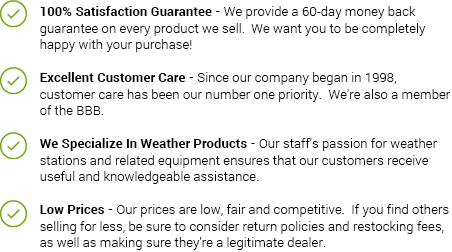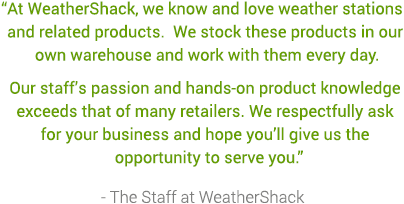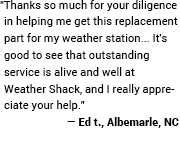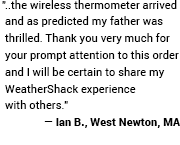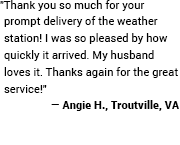
Sensor Maintenance
Information On Weather Instruments Maintenance To ensure that your home weather station sensors are transmitting accurate weather measurements, they must be properly maintained. Preventive sensor maintenance is an important aspect of that effort and each sensor should be physically examined on a regular basis, helping to head off future problems and protect your investment. Be sure to review and follow your weather station manufacturer's cleaning and maintenance recommendations. For example, do not assume that all moving parts need lubrication, find out for sure! The following are general guidelines for the maintenance of weather sensors: Temperature & Humidity Sensors - Remove any dirt and debris that has accumulated on the thermometer hygrometer solar radiation shield. During the winter, be sure to remove snow and ice as that will affect temperature and humidity readings. Anemometers (wind sensor or wind gauge) - Annually inspect your anemometer, then clean and lubricate (if required) the bearings. Also verify the orientation of the wind vane to ensure accurate directional wind measurement readings. Throughout the rest of the year, make sure the anemometer rotates freely by observing it during light wind conditions. If it doesn't appear to be turning freely, stops abruptly or makes a grinding sound, a closer examination is in order as it's likely the anemometer needs cleaning. They can also be symptoms of bad bearings, so if the problem remains after cleaning, consult the manufacturer. Anemometers can sometimes ice up during winter weather events and you should take great care if you decide to remove it. Plastic is usually very brittle at low temps and can break relatively easy. As an option, you could wait until it melts away naturally or bring the sensor inside. Rain Gages (rain sensor) - Avoid inaccurate rainfall readings by checking the rain collector (funnel) often for obstructions (dirt and debris). Birds have also been known to nest in them. Remove the rain collector and check underneath it as well, but do so cautiously as wasps, spiders, and other insects can set up housekeeping inside the base. Dust and debris can also affect the operation of a tipping bucket rain gauge. Clean the buckets and collector funnel gently using water and a mild liquid detergent, rinsing thoroughly. Solar Radiation & Ultraviolet Light Sensors - Keeping the lens/cover free of dust, dirt, and debris is critical to ensuring accurate readings from these solar sensors. Examine agricultural weather station sensors on a weekly basis. |
Sensor Power Sources - If you you have a solar powered weather station, make sure the solar panels are kept clean. If powered by batteries, follow the manufacturers recommendations concerning battery replacement. You may find it worthwhile to change out the batteries a bit more frequently than recommended to ensure that reliable communication is maintained between console and sensors. If your sensors use rechargeable batteries, follow the manufacturers recommendations regarding replacement. Consider using lithium batteries during winter if temperatures are expected to remain below freezing for an extended period of time. Lithium batteries have superior cold temperature performance compared to alkaline batteries and will function at extremly low temperatures. They are available at most stores selling electronics or cameras. Alkaline batteries will lose power in cold temperatures and will freeze somewhere around -4°F (-20°C) and stop working. This will not harm your temperature sensor and when the temperature goes back above freezing, the batteries will thaw and start working again. A note on remote sensors with liquid crystal displays: Even though a remote sensor with lithium batteries should operate down to about -40°F (-40°C), the display will probably fade out at about 0°F (-17.8°C). This is normal behavior for LCDs, and the display will reappear when the temperature warms back up. Sensor Re-calibration - Sensor readings may begin to drift over time (several years) and require re-calibration. If you suspect that this is happening, first compare your readings with those of a nearby calibrated station (NWS office or airport weather station). If this check confirms that your sensor needs re-calibration, consult your owners manual and/or contact the manufacturer for instructions. All content on the WeatherShack Education Center is Copyright 2002-2020 WeatherShack.com. This material may not be reproduced, displayed, modified or distributed without the express prior written permission of WeatherShack.com. For permission, please contact [email protected]. |

